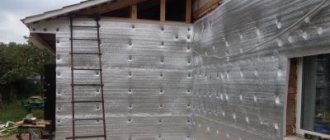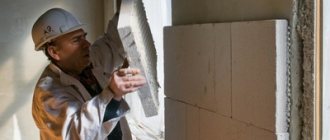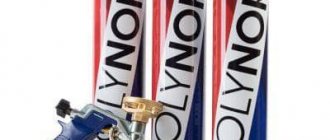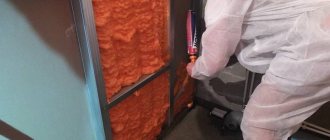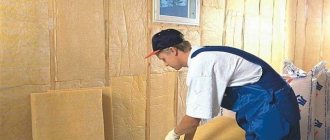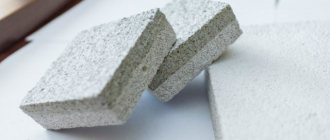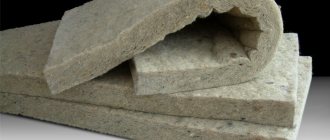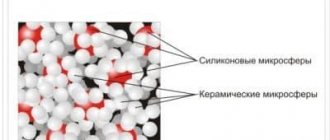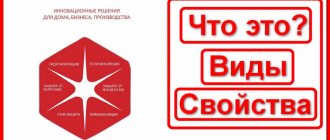What is liquid thermal insulation
Let me start with the fact that the development of this product has been carried out since the seventies in the military space industry of both our country and America.
A lightweight material was required, but with unique heat-insulating properties. Today, all advanced technologies have migrated into our everyday lives precisely from the military industry. And warm paint in this case is no exception. Now all the best is for peaceful purposes. Insulation paint is a polymer binder made of acrylic or latex. It also contains fillers made from the smallest ceramic, glass or polymer beads and various additives that determine different areas of application. In a word, this is a complex chemical compound, the development of which took a lot of time and money.
Thermal insulating paint for walls: composition and scope of application
The composition of paints for thermal insulation is a mixture of:
- fillers;
- evacuated glass beads;
- water;
- acrylic-based dispersions;
- fiberglass;
- foam glass;
- perlite (in expensive types, perlite is replaced with ceramic microspheres).
Scope of material application:
- facades;
- pipes, including heating mains, water supply, gas;
- heating boilers;
- insulation of tanks and industrial equipment;
- walls in the apartment;
- basements.
The paint is applied in a relatively thick layer (4 mm), and therefore its use can replace several millimeters of external insulation or serve as an additional heat preservation system. The condition for the thermal insulation function is an even layer around the perimeter, and therefore it is better to use a spray gun to evenly distribute the viscous consistency
Classification of thermal compositions
The classification of the dye is carried out in two directions.
Two types according to manufacturing method:
- water CM - covers the pipes of the heating system, does not contain toxins;
- Acrylic-based CM is universal and interacts with many materials.
Three types depending on the place of application:
- universal CM - walls inside rooms and on the street side, ceiling, floor are covered;
- energy-saving façade paint – the moisture resistance indicator is high and allows the material to be used for painting the surface outside;
- heat-insulating paint for pipes - protects water and gas pipelines, pipes of ventilation and air conditioning systems.
Composition of thermal insulation paints
Types of thermal insulation paints differ in composition. Differences in composition exist between similar dyes from different manufacturers. But despite all the differences, there are 4 elements that make up most thermal paints:
- The basis . Other names are base or filler. This is a connecting link that evenly distributes the remaining components over the insulated surface. In thermal paint, two types of base are used - water-acrylic and acrylic dispersions. Because of this filler, applying the composition has become less labor-intensive, and the paint has high adhesion to various types of surfaces, as well as an increased speed of drying and polymerization.
- Modifiers . Various impurities that determine the temperature and strength characteristics of the paint. These are the preferred coating materials, making it possible to work indoors, as well as at sub-zero temperatures. For example, rubber, latex or silicone are used to increase the elasticity of the composition.
- Ceramic granules . Small ceramic balls with a technical vacuum or low-inert gas inside. Due to their spherical shape, the balls are evenly distributed in the thermal insulation layer, and due to vacuum or gases they reduce the level of thermal conductivity.
- Pigments . Typically, the compositions are supplied only in white or gray colors, but manufacturers meet customers halfway and add special pigments to achieve the desired color of the insulating paint.
Description of the composition, its components
The innovative material is designed to interact with a surface that releases heat and loses it completely. Insulating materials of the previous generation are aimed at retaining heat, eliminating cold bridges. Thermal insulating paint is endowed with heat-reflecting quality. This means that the heat remains, does not go away, and 70% of it comes back. A similar effect is created due to the vacuum environment inside the filler. Infrared waves in a vacuum environment increase speed by 1000 times. This leads to the fact that only 30% is lost, 70% comes back after being reflected. This operating principle of KM allows you to effectively insulate facades, walls, roofs, and other surfaces of housing construction.
Important: heat loss is reduced by up to 40%. Despite the fact that the coating repels water and moisture, the base does not stop breathing.
Thermal insulation paints consist of:
- water-acrylic mixture is the binding base. The component affects the uniform distribution of the coating and the adhesion of the insulation to the base;
- microscopic ceramic granules that are filled with gas - fillers. A high level of thermal insulation of the material is created thanks to them;
- silicone, rubber, other elements - additional components. They are responsible for the elasticity of the coating and its water resistance.
When the applied CM dries, vacuum voids occupy 75-80%. Material 2-4 mm is applied. This replaces the use of insulation in its traditional form. Visually, the composition is as thick as homemade sour cream. The base color of the paste composition is white or gray. It is recommended to spray it. Then the coating will lie evenly.
The protective layer of the innovative material will last 12-40 years. It tolerates temperatures from -70°C to +260°C.
Functional Features
The quality of thermal protection of thermal paint directly depends on the applied layer and the number of stains. However, it is also not recommended to apply an excessively thick layer; the best option is 2-4 paintings, no more than 6 mm thick. The number of layers depends on the type of heat-insulating liquid material, as well as on the type of surface to be applied. The service life is 12-40 years, and the temperature characteristics are -70°C, +260°C.
Main advantages
The main advantage of liquid insulation for work inside buildings is thermal insulation without reducing space. It is important to note the material’s resistance to temperature changes, which occurs in winter during the heating season: it’s minus outside and plus inside, condensation collects, which forms a favorable environment for the development of fungus. Additional benefits:
- environmental friendliness - the paint does not emit harmful toxic compounds at high temperatures and does not react with other building materials;
- saving on heat bills due to thermal insulation;
- strengthening treated surfaces.
Thermal paint application methods
A roller or brush may be used inside the building. But this technique increases the consumption of material; with a maximum thickness of 4 mm, the layer with manual painting reaches 5-6 mm. The quality of thermal insulation in such a situation does not suffer, but material waste cannot be avoided. A practical and economical application option is a spray gun.
To paint different surfaces you need different amounts of material: loss coefficient for concrete, brick, wood - 5-10%, metal - 3-6%.
Thermal insulation paint - working with the material
Separately, it is worth noting the ease of working with the material. When organizing insulation of the facade of a house using polystyrene foam, it is necessary to perform a whole range of operations: fasten the slabs, install reinforcing mesh, plaster the walls and paint them. Insulating paint eliminates this need. It is enough just to apply one or two layers of material to the surface to be treated using a brush or roller, if the area is not too large. When processing building facades, you can use a spray gun for greater convenience of the operation. The simplicity of the insulation process using thermal insulation paint eliminates the need to involve specialists and allows you to do the work yourself. Heat-insulating paint allows you to save a lot of time and money. It lays on any surface in a perfectly even layer, even if the base is deformed. The hardening process of the insulation paint takes 24 hours. After this time, the thermal paint turns into an elastic and very durable film. It is this that provides thermal insulation of a room or a separate surface.
The area of use of insulating paint is constantly expanding. Thermal paint Akterm can be used as a heat insulator for coating water supply pipelines, water heating equipment in boiler houses or oil and gas storage facilities. Application of the material is possible on a metal surface of any shape. Thus, insulating paint becomes an ideal option for providing thermal insulation of pipeline shut-off valves. At the same time, the finished coating can be used in a wide temperature range: from -60 to +230 degrees Celsius, maintaining its performance qualities. The service life of the material reaches 15 years or more.
If we talk about the insulation of premises, here thermal insulating paint finds its application as the main and additional thermal insulation. This material can be applied to the interior walls of the house and other elements of its structure. Ultra-thin thermal insulation makes it possible to significantly reduce the cost of maintaining optimal temperature inside rooms, while at the same time destroying mold and condensation on surfaces. Insulation paint can be applied to brick, concrete, drywall or wood. At the same time, you can glue wallpaper on top of the liquid thermal insulation or carry out any other decorative work.
Fighting condensation with heat paint
Liquid thermal insulation allows you to avoid the manufacture of complex structures necessary for attaching a thermal insulation layer near the roofs of hangars and residential buildings. Painting pipelines of engineering systems is much cheaper than protecting pipelines with polystyrene foam shells, winding with basalt wool, and then waterproofing the insulation.
Condensation control is available to a home craftsman with minimal painting skills. Liquid thermal insulation is sold in convenient buckets and jars, is completely ready for use, and has instructions for use. The weight of the roof practically does not increase when applying a millimeter layer, while the comfort of using the premises increases many times over.
Varieties and their features
Thermal insulation paints are made on a water basis and with the addition of acrylates. Each type of product has its own advantages and disadvantages.
Water based
Water-based thermal insulation paint dries to form a durable and elastic layer. This paintwork is intended for work indoors and outdoors, as well as for painting heating mains.
What is the weight of paint contained in 1 liter and its density, how to convert from kg to l
Pros and cons: does not require ideal conditions when painting; can be used at any temperature; dries, creates an elastic and durable coating; less durable than an acrylate composition; high price, high consumption.
Acrylate
This heat-insulating paint, when drying on the wall, resembles a layer of plastic or rubber. The coating can serve as a base for painting. Mainly used for outdoor work.
Pros and cons: versatility (for any type of surface); when dry, it creates a very durable coating; requires careful preparation of the base; high price.
Main manufacturers and approximate cost of products
The number of manufacturers of thermal paints is constantly increasing. But there are companies that have already proven themselves on the positive side.
Prices for thermal paint vary not depending on the manufacturer, but on specialization. They range from approximately 300 rubles per liter of universal paint to 500 rubles per liter of heat-resistant, anti-corrosion thermal paint with the possibility of application at temperatures down to -20°C.
- Akterm. Thermal insulating paint from a Russian manufacturer. It has high adhesiveness, heat resistance and good vapor permeability.
- Corundum . Universal water-based material. Suitable for both indoor and outdoor use.
- Astratek . The paint resists ultraviolet rays well, so it is used for outdoor work.
- Alfatek . Liquid thermal insulation, available on the market with several types of paint for various surfaces and application temperatures. There is a composition that can be applied at -20°C, including on poorly prepared metal surfaces.
- Teplomet . The line also includes thermal paint that can withstand temperatures up to 400°C, as well as a particularly elastic composition that can withstand deformations of up to 2 mm.
- Tezolat . Paint with good reflectance of ultraviolet and infrared rays, as well as vapor conductivity.
- Kare . Used for waterproofing and thermal insulation.
- RE-THERM . The advantages include high resistance to mechanical damage.
- TSM Ceramic . The line includes “Home” thermal paint, specially designed for convenient work in small areas. This type is maximally adapted for application with a brush and is packaged in 1 liter and 3.6 liter containers, which sets it apart from other industrial “versions”.
- Armor . One of the most common insulation materials. There is a special “fire retardant” composition on sale.
Basic recommendations for selection
Thermal paints are available on the market for various surfaces and conditions of use. Therefore, when purchasing, you need to consider the following parameters:
- For what purposes is such thermal insulation needed ? This includes what material the surface that needs insulation is made of (brick, wood, metal, concrete) and the area of insulation. The main required characteristics of thermal paint: fire resistance, heat resistance, high vapor permeability, anti-corrosion properties. But you need to consider where the insulation will be done. If indoors, it is important to select appropriate formulations without harmful components.
- What areas are supposed to be painted and in what way . If you use a brush or roller for painting, you need to understand that they consume more material than a spray gun. In addition, they lay thermal insulation in a less uniform layer, but are cheaper and are quite suitable for small areas.
- Select color . In most cases, the color of the thermal paint is white or gray, but some manufacturers offer ready-made paints in different colors. And sometimes colors are added at the client’s request without losing the original characteristics.
Another aspect worth paying attention to is the choice of original. If you take products in branded stores, then the risk of taking a useless counterfeit is small, but on the market you need to carefully study the documentation and packaging. If something suddenly alarms you, then you should refuse the purchase. Sellers in such places may not even know that they are selling non-original paints. Foreign expensive compounds are often counterfeited, but there are also counterfeits among domestic products.
For interior work
To paint objects and walls indoors, you need insulating paint that does not contain toxic substances. The product must be labeled “for interior use.”
This paintwork is applied in the thinnest layer and does not take away extra meters from the room.
For outdoor use
To insulate the facade and protect heating mains, durable heat-saving paint is needed. The composition must have high levels of water resistance, frost resistance and heat resistance. You can work with this paintwork in any weather conditions (except rain).
How to choose?
When choosing a thermal insulation material, it is important to consider the location of the painting work (indoors or outdoors) as well as the type of surface being treated. Before purchasing thermal paint, it is also advisable to familiarize yourself with the list of popular manufacturers and study reviews of their products.
Some recommendations for selection:
- for exterior work, you should select paint with high levels of water resistance and heat resistance;
- for indoor work, you need to purchase paint that does not contain toxic substances;
- the mixture for painting gas and water pipes must have the highest heat resistance.
It is worth remembering that when painting, quite a lot of heat-insulating composition is consumed. Before purchasing a suitable liquid insulation, it is important to calculate in advance the required amount of mixture.
When calculating, the following factors must be taken into account:
- Surface area to be painted.
- The type of material that will be coated with paint and varnish. To cover a wooden, brick or concrete surface, paint overconsumption can range from five to ten percent. Painting the metal may require an additional three to six percent of the mixture.
- Presence of defects on the surface. If there are small cracks or irregularities, it is worth considering that painting such areas will require an additional amount of liquid heat insulator. Overconsumption of the mixture can reach forty percent.
- The number and thickness of paint layers you plan to apply to the surface. Recommended coating thickness for different materials:
- For concrete - one and a half millimeters.
- For wood - two millimeters.
- For metal, brick, cellular concrete and expanded clay concrete - two and a half millimeters.
To calculate the approximate amount of paint, you need to multiply the surface area, the consumption rate (liter/sq. m) and the number of intended layers.
Famous brands
You can purchase heat paint at any hardware store. Well-known brands on sale:
| Brand | Types of CM | Performance indicators | Area of use | Price |
| Korund, Russia | Classic | Container – can 3, 10 kg or 20 l. For indoor and outdoor work, tolerates -60°C to +250°C. | Cooling of contents in heating pipes, steam pipelines; reduction of heat loss – facades, external walls; heat preservation - walls inside the house, train stations, airports; mold protection – bathroom, ceiling | 10 l – 5,700 rub. |
| Anticorrosive | Even metal with rust is covered. Its traces are removed with a brush and can be painted. | 10 l – 6,500 rub. | ||
| Winter | You can work at -10°C. Insulation outdoors in winter is allowed. | 10 l – 6300 rub. | ||
| Facade | A minimum 1 mm layer with high vapor permeability and water resistance is applied to the facade. | 10 l – 6,000 rub. | ||
| Environmentally friendly Astratek, Russia | Station wagon | Quality is preserved after 5 freezing cycles. Density is regulated by water. Tolerates -60°C to +260°C. | For thermal insulation of walls on the street side inside housing construction. | 10 l – 107 dollars |
| Metal | KM's base color is grey. Permissible operating mode -60°C to +200°C. | Protection against metal corrosion; it covers the roof. | 10 l – 6,700 rub. | |
| Facade | The base color is white, can be tinted. Apply with a spatula or spray. The material is vapor permeable and water-repellent. | Heat loss insulation layer on the façade | 10 l – 7,050 rub. | |
| Liquid ceramic coating – KM Bronya | Classic | Prevention of corrosion, condensation, and UV rays from the sun. The coating increases the service life of the object. | Stopping heat loss on heating system and water supply pipes, chimneys. | 10 l – 4,200 rub. |
| Anticorrosive | A composition with anti-corrosion properties adheres to rust. | Heat insulation on the surface of the metal base. | 10 – 5,200 rub. | |
| Winter | Components: acrylic polymers and tiny foam glass granules, the layer is not afraid of frost. The material can be worked at -35°C. | 10 l – 3,900 rub. | ||
| Facade | A covering layer with a high vapor permeability value is applied at 1 mm. | The facade of the house is saved from microorganisms and fungus. | 10 l – 4,200 rub. |
Areas of use
The material itself is suitable for painting in the following areas:
- insulation of equipment used in industry;
- processing of various containers;
- agricultural production;
- insulation of basements;
- protection of heat supply systems;
- vehicle processing;
- thermal insulation of housing, inside and outside;
- work with air conditioning systems, steam and gas pipelines, utilities;
- protection of pipes from freezing processes (heat-insulating paints are especially needed here);
- façade insulation of external walls.
Such protective paints for metal and other materials will find a place in almost any area of the national economy. They provide excellent competition to traditional insulation methods.
Paint Performance Assessment
Experts' assessments regarding thermal insulation paint are ambiguous.
On the one hand, long-standing disputes have not yet completely subsided, when, under the guise of a “miracle remedy,” compounds were advertised and sold, the quality of which left much to be desired. And there are still supporters of this point of view who believe that this is a hoax and technically impossible.
On the other hand, technology is developing and new components are constantly being developed to improve the performance of thermal insulation paints. Moreover, both in terms of thermal conductivity and in relation to other characteristics. Of course, there is a possibility that the figures in advertising are slightly exaggerated.
Considering both opinions, we can conclude that the truth is somewhere in between. The characteristics of thermal insulation paint are not unique, but they may well help out in certain situations.
How does modern insulation paint work?
Due to its unique properties, liquid insulation already begins to work at a thickness of 1 mm. This breaks the whole stereotype in our usual insulation. After all, we are used to the more the better. In this case, no more is needed. 1 millimeter of heat-insulating paint is approximately equal in thermal insulation to 5 cm of mineral wool insulation. Agree, this is a worthy indicator.
Once upon a time, while studying at school, we were taught that vacuum is the best insulator. Sound, heat, and electricity do not travel through it. This explains the phenomenal effect of using heat paint. Since there is a vacuum in the microscopic ceramic balls, the result is a kind of mini-thermos, of which there are millions, and maybe billions.
Due to such a complex molecular structure, thermal energy is reflected. All three types of heat transfer, namely convection, conduction and radiation, are almost completely reflected. The protected surface always remains pleasantly warm.
Distinctive characteristics and properties of thermal insulation paint
Ease of application is a big plus. Thermal insulating paint can be applied in a variety of ways, including roller or spray. When the area to be treated is large, a spray gun will be more useful.
Akterm is a liquid thermal insulation similar to paint. This is a practical consistency suitable for various types of surfaces. With prolonged exposure to air (about 24 hours), the mixture polymerizes. So it becomes a thermal barrier. In summer, thermal paint reflects 95% of the sun's rays. And in the winter months, on the contrary, they return (this volume will be about 70%). AKTERM does not require special conditions for application. So, a temperature of at least 20 degrees C is sufficient. And during operation, the product will withstand up to -60°C. And if the surface with paint becomes dirty, it can be easily washed, and it will again become not only functional, but also aesthetic.
Today, energy-saving technologies are becoming increasingly relevant as a construction issue. The modern market offers consumers innovative developments in this area, embodied in high-quality universal materials. They are designed to provide maximum protection of the home from adverse natural factors and proper thermal insulation of the premises.
Thermal insulating paint is a new product on the building materials market. Its purpose is to reduce heat loss in a building, in particular in a house. Having a liquid consistency, the material is easily applied to any type of surface, even deformed. The material is completely safe for human health and the environment, being a composite thermal paint, which includes a polymer matrix and a filler - hollow microspheres.
The range of properties of heat-insulating paint is very wide:
- Prevents cold from penetrating into the room
- Prevents corrosion on metal surfaces
- Excellent heat retention
- Prevents moisture from entering, eliminates mold
- Eliminates condensation
- Saves electrical energy
The thinnest layer of insulating paint can completely replace the traditional thermal insulation system of a house. Liquid insulation has a very reasonable cost and efficiency, which is also one of the factors in favor of its choice.
Thermal insulation with paint for residential buildings
However, when insulating residential buildings with paint, it is recommended to use it in combination with another heat-protective material, for example, mineral wool. Using this technique, the layer of internal insulation can be made a little smaller or the thermal insulation of the already installed insulation can be increased. The use of thermal insulation on the roof will prevent heating, thereby normalizing the temperature inside the building.
Applying liquid insulation to a flat roof
But keep in mind that even seemingly minor damage to this coating will certainly affect the quality of the thermal insulation. It’s one thing when polystyrene foam, the thickness of which is several centimeters, is damaged, and another thing when a thinner layer of paint is damaged. But this problem is easy to fix - you just need to paint over the damaged area with a fresh coat of paint.
Manufacturers of liquid thermal insulation confidently claim that the coating can retain its thermal insulation qualities for up to 40 years. As you understand, we cannot yet prove or disprove this. As they say, wait and see.
Tips and tricks
- When choosing a suitable composition, you must carefully study its purpose and technical characteristics . For example, mixtures intended for indoor use outside buildings will not provide the proper level of protection against heat loss and the negative effects of the external environment.
- Before applying the composition to the surface, the base must be cleaned of dirt and degreased . It is most convenient to apply the mixture to large areas using a sprayer. Hard-to-reach places must be painted with a paint brush.
- Each modification of the paint and varnish material may have its own operating temperature range Water-based mixtures can usually be applied at an air temperature of at least 7 degrees. Some acrylic compositions for facade work can be painted at temperatures below -20 degrees.
- Insulating paint and varnish material is usually applied in no more than three layers , and the thickness of one layer must be at least 0.4 millimeters. The mixture is applied quite easily, leaving no streaks on the surface. In cases where it is necessary to paint concrete or brick bases, it is recommended to first treat them with a deep-penetrating primer mixture.
Advantages and disadvantages
Liquid heat-reflecting composition has significant advantages over other insulating materials. Its advantages include the following qualities:
- Use significantly reduces heating costs.
- The paint layer hides cracks and irregularities well.
- The composition adheres perfectly to the surface and paints even hard-to-reach places.
- It has good protective properties. Metal protects against rust, and concrete protects against destruction.
- The protective layer is highly resistant to temperature and mechanical influences, as well as ultraviolet radiation.
- The material is environmentally friendly and does not cause allergies.
- Has a long service life.
- Prevents the appearance of fungi and mold, as well as condensation on the surface.
- The composition is easy to use. Applying a protective layer to the surface does not require any special skill. Any person can handle the job.
In addition to its advantages, thermal insulation paint has some disadvantages. The most significant of them include:
- Large consumption of material to form a high-quality insulating layer.
- High price.
- Low fire resistance.
Types of liquid insulation Bronya
VIRC constantly conducts scientific research work, which allows the company to improve materials manufacturing technologies, as well as produce new series of coatings.
Currently, two main types of thermal insulation liquid materials can be distinguished:
Types of materials
Next, we will take a closer look at the purpose and features of each of these series.
Dye
Bronya paint is a universal ultra-thin thermal insulation. Its main features include weather resistance, temperature resistance and vapor permeability. In addition, this coating, like other types of liquid thermal insulation from this manufacturer, is environmentally friendly.
Application area. Thermal insulation coating can be used to insulate the following structures:
- Facades;
- Internal walls;
- Roofs;
- Pipelines;
Paint can be used for thermal insulation of pipelines
- Window slopes;
- All kinds of containers, etc.
Thermal insulating paint can be used to insulate facades
This coating can be applied to a variety of surfaces, such as:
- Metal;
- Concrete;
- Wood, etc.
Thermal insulation adheres well to a wooden surface
Thermal insulation paint can be applied with a roller or brush
Characteristics:
| Options | Magnitude |
| Service life, years | More than 15 |
| Permissible temperature, °C | -60 to +200 |
| Thermal conductivity, W/m °С | 0,0012 |
In the photo Bronya Classic is a basic modification of heat-insulating paints
Varieties. There are several modifications of thermal insulation paint from VIRC on sale:
Classic. Basic modification, which includes all the above characteristics;
The Standard series has a maximum temperature limit of up to 140 degrees
Standard. Cheaper analogue of the Classic. It differs only in its limited maximum temperature - up to 140 ° C;
In the production of Universal series paint, import-substituting technologies are used, which makes it cheaper
Station wagon. Another budget heat-insulating paint. The characteristics are similar to the Classic and Standard series; Cheaper costs are achieved through the introduction of import-substituting technologies;
Anticor paint can be applied to rusty metal surfaces
Anticorrosive The material is intended for metal surfaces covered with corrosion. The coating not only transforms old rust, but also prevents the appearance of new ones. Otherwise, the characteristics are the same as for other paint modifications;
Winter series paint can be applied at temperatures down to -35 degrees
Winter. The peculiarity of this coating is that it can be applied at temperatures down to -35 degrees.
Price:
| Name | Price for 1l |
| Classic | 450 |
| Standard | 360 |
| Station wagon | 320 |
| Anticorrosive | 460 |
Insulating putty can be applied in a layer of 1 mm
Manufacturers
In order not to make a mistake in choosing a high-quality thermal insulation coating, it is better to purchase products from well-known and trusted manufacturers. Among Russian manufacturers of thermal insulation paints, four leading ones can be identified:
One of the most popular manufacturers of thermal insulation mixtures is.
Liquid heat insulators from this company can be used to treat the following surfaces:
- metal containers;
- rooms with high humidity levels;
- boiler rooms;
- facade of buildings;
- surfaces inside residential and administrative buildings;
- chimneys;
- motor transport, passenger aircraft, railway cars;
- pipelines.
produces several types of paints and varnishes, depending on their scope of application. The following modifications of Korund products are produced:
- "Classic". A universal coloring composition that is suitable for external and internal work. Widely used in building construction.
- "Facade". This heat insulator is designed for treating concrete walls. Painting can be done both outside and inside the room. The material has a high level of waterproofness and heat permeability. The coating protects the walls from overheating in the warm season and from freezing in the cold season.
- "Lotus". It has the same qualities as the “Facade” modification. This material is intended for application to the surface in the form of a final layer.
- "Winter". A distinctive feature of this modification is that the dyeing procedure can be performed at sub-zero temperatures. You can work with such material at temperatures not lower than -10 degrees.
- "Anticor". Used for painting metal surfaces. This paint and varnish material protects the metal from atmospheric influences and prevents corrosion.
"Termalcom"
produces a line of heat-insulating paints "Astratek". The paint and varnish coating is made on the basis of polymers. offers products with high performance characteristics at reasonable prices.
Liquid thermal insulation "Astratek" is widely used in the construction, industry and housing and communal services sectors. There are six modifications of this company’s thermal paint:
- "Astratek Universal". Suitable for painting all types of surfaces. It has a high level of vapor permeability, which helps prevent the appearance and spread of mold on the surface.
- "Astratek Metal". Used for painting metal structures and devices that are operated in unfavorable conditions of high humidity. Such a coating will increase the service life of products made of ferrous and non-ferrous metals, prevent corrosion and eliminate the formation of condensation.
- "Astratek façade". It is used for thermal insulation of building facades.
- "Astratek NG". It is a special fire-resistant modification of the material.
- "Astratek Universal BC". An all-season coating that is temperature and weather resistant.
- "Astratek decor-acoustic" It is used as additional thermal insulation of walls, and also significantly improves the acoustics in the room.
GC VIRTs "Bronya"
The products are widely used in various fields of construction and industry. The manufacturer offers the best conditions on the thermal paint market in terms of price/quality ratio.
Thermal insulating ceramic paint "Bronya" was previously used mainly for painting gas networks and water supply systems. However, the company regularly expands its line of thermal insulators with new modifications.
Thermal paints are divided into three groups:
- basic modifications;
- budget modifications;
- special modifications.
"Akterm"
is one of the leading manufacturers of liquid thermal insulation. The company independently develops a unique manufacturing technology for its products. In the production of heat-retaining materials, only high-quality raw materials are used.
Liquid thermal insulation currently has fifteen different modifications, differing in composition and properties.
The main functions performed by Akterm thermal insulation coatings are as follows:
- preventing the formation of condensation;
- anti-corrosion protection;
- water protection;
- thermal insulation;
- fire protection
Recommendations for application:
- Before using ultra-thin insulation, it is necessary to prepare the surface to be treated: remove rust, clean from dust and grease, and prime if necessary. It is advisable to apply the paint and varnish composition at a humidity of no more than eighty percent and a temperature of at least seven degrees Celsius.
- When carrying out external painting work, it is better to choose calm weather. Due to wind, paint consumption can increase by up to five percent. The following tools can be used to apply the coloring composition:
- roller;
- spray gun;
- paint brush.
- It will be most convenient to apply the mixture using a spray gun. If the ultra-thin insulating mixture is too thick in consistency, it can be diluted with water. Also, do not forget about using a respirator to protect your respiratory organs.

